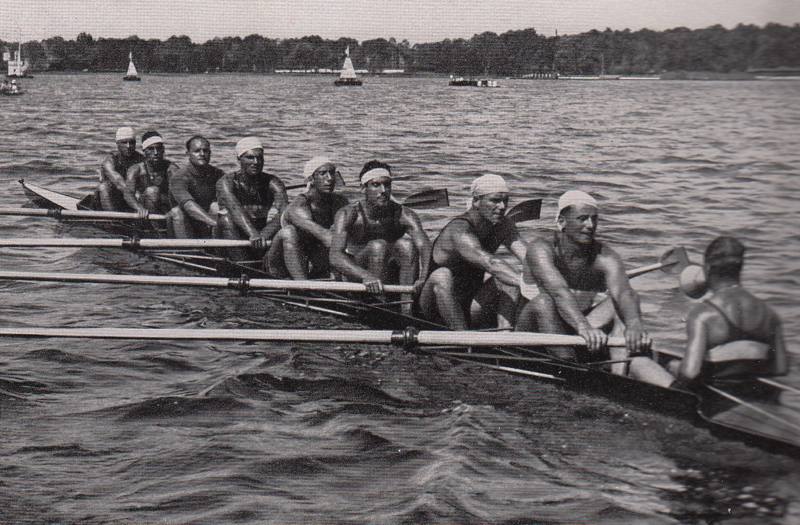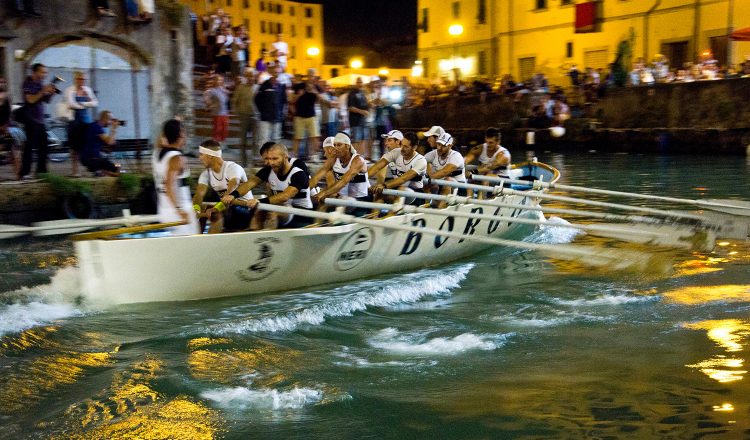In rowing jargon, Eight is the name given to the race boat with eight rowers and cox: eight oars resting on overhanging rowlocks, eighteen meters long by sixty centimetres wide. Of all race boats, it is the longest, the most difficult to steer and yet the most aspired to because when you climb in you have to become a team: one soul, one heart and one oar-beat into the water.
This is what the Scarronzoni, the most famous Eight in Italian sporting history of all time, managed to be: twelve times national champions, two times European champions and two times Olympic runners-up in Los Angeles in 1932 and Berlin in 1936.
All eight were born in Livorno and all of them were harbour dockers, labourers, workers, and members of the crews of Risiatori, who, by force of oars, competed to be the first to reach the merchant ships and unload them. And who were also prepared to slip between the waves when there were ships to be saved.
Big-hearted, bold and mighty, as were also the Scarronzoni, who rowed only by force, paying little attention to technique, at least in the early days of their sporting adventure. Unable to row in a straight line, they would sometimes drift, or “scarrocciare”, hence the rather unflattering nickname, which they never lost.
The Scarronzoni, an adventure spanning two decades of hard work and self-sacrifice in the will to avenge defeat and to win. Even when they lost by a hair’s breadth, for this team of strapping young men of the people, tanned from working all day in the hot sun and for whom a torn shirt and a pair of patched trousers were the smartest clothes they had, victory was still theirs.
Challenging the Italian Federation’s bias for the wealthier and more aristocratic rowing clubs, the Scaronzoni proved their worth and even managed to beat the award-winning rowing teams from Oxford and Cambridge.
But not the Americans. There was no way with them. Two hundredths of a second in Los Angeles and six in Berlin separated the Scarronzoni from the American boat and from ever winning an Olympic gold medal, despite doubts, which linger to this day, about the authenticity of the negative of the photo finish in Los Angeles.
Nevertheless, on each occasion of their return to Livorno they were welcomed as champions by thousands of cheering fellow townspeople. The Scarronzoni had got their revenge and their achievement, flying over the water, was for the whole city. Just like the Musketeers, all for one and one for all.
The Scarronzoni Crew.
The Scarronzoni. Olympic Games in Berlin 1936
Video: https://youtu.be/m05nsDBEblQ
The Rowing Races
When we mention water in Livorno, we mean the sea, above all. That same sea that flows into the town through the veins of its canals: the Fossi Medicei. Like the salty air of the sea that sweeps through the tamarisks of the waterfront, between the sea and the people of Livorno there is an intense, genuine and rugged bond. A relationship that is somehow renewed every year with one vow: The Rowing Races. A sort of wedding ceremony in which oars and salty water meet, involving the whole town to participate in a ritual of sport, passion, and folklore.
The tradition of the Rowing Races between the quarters of the town has origins dating back to before Livorno was given city status in 1606. By the 16th century, great events were already being celebrated with regattas, “pali di barchette” boat races and rowing competitions inside the port. In the eighteenth and nineteenth centuries these “water festivals” were the subject of prints and canvases, and, in the meantime, the Risiatori, whose mighty arms had also begun to drive the boats of the competing districts, made their appearance.
Four annual events. The first, Palio dell’Antenna, takes place on 21 May. This competition was recently revived and differs from the other three. It takes place in the Darsena Nuova and sees the town quarters challenge each other to arrive first at a high pole (the Antenna) placed in the middle of the of the competition area. At the top of the Antenna there is a waving cloth (the Cencio), whose conquest confers the victory to the quarter. Then, in June, there is the gruelling Coppa Risiatori: 8 kilometres offshore, from the Meloria Shallows to the harbour. Again in June, the Coppa Barontini, a time trial and perhaps the most fascinating of the four competitions. It is held at night in the Fossi Medicei, the embankments of which, that evening, overflow with people, sounds and colours. Lastly, on the first Sunday of July, the Palio Marinaro, which is held offshore in front of the impressive Terrazza Mascagni. This is perhaps the competition that stokes the fire of competition between the districts more than any other.
For all these reasons, the Rowing Races are somehow the emblem of the relationship that binds Livorno to its sea and, at the same time, a representation of the character of its inhabitants.
Coppa Barontini. (Photo: Filippelli).
Palio Marinaro
Video: https://youtu.be/j-JYw0hGZds
Head image: Palio Marinaro. (Photo: Filippelli).
La Livorno degli Scarronzoni e delle Gare Remiere
Ottoè il nome con cui, nel gergo del canottaggio, si indica l’imbarcazione da gara con otto vogatori più timoniere a bordo: otto remi poggiati su scalmi aggettanti, diciotto metri di lunghezza per sessanta centimetri di larghezza. La più grande, la più difficile, la più ambìta da tutti i vogatori, perché saliti lì sopra bisogna diventare una squadra: una sola anima, un solo cuore, un solo battito di remo nell’acqua.
È questo che riuscirono a essere gli Scarronzoni, l’Otto più famoso della storia sportiva italiana di tutti i tempi: dodici volte campioni nazionali, due volte campioni europei e soprattutto altre due volte vicecampioni olimpici a Los Angeles nel ’32 e a Berlino nel ’36.
Tutti livornesi, tutti scaricatori di porto, manovali, operai, Risiatori: Quegli equipaggi che facevano a gara, a forza di remi, per toccare per primi i mercantili in arrivo e sbarcarne il carico. Gli stessi che poi erano pronti a infilarsi tra le onde quando c’era da salvare qualche nave.
Erano così anche gli Scarronzoni: generosi, sfrontati, possenti. Tanto da vogare solo di forza, senza troppa attenzione alla tecnica e finire per “scarrocciare”, almeno agli inizi della loro avventura sportiva: da cui il nome simpaticamente irriverente che alludeva al loro procedere non sempre rettilineo e che rimase loro addosso per sempre.
Una storia, quella degli Scarronzoni, durata venti anni: venti anni fatti di fatica, di spirito di abnegazione, di voglia di rivalsa e di tante vittorie. Anche quelle mancate di un soffio, ma che vittorie furono comunque per questa squadra di ragazzoni del popolo, sempre abbronzati perché a lavoro tutto il giorno sotto il sole, che la cosa più elegante che avevano da mettersi era una camicia strappata e un paio di pantaloni rattoppati.
Una squadra che, però, lottando anche contro la Federazione Italiana – favorevole a più aristocratici e ricchi circoli di canottaggio -, arrivò a giocarsela alla pari e persino a sconfiggere blasonati equipaggi di vogatori provenienti da Oxford e Cambridge.
Ma gli americani no. Con loro non ci fu verso. Due centesimi di secondo a Los Angeles e sei a Berlino divisero per sempre gli Scarronzoni dalla barca statunitense e dalle medaglie d’oro olimpiche; seppure col dubbio irrisolto di un intervento sul negativo del fotofinish di Los Angeles.
Eppure, rientrati a Livorno, entrambe le volte furono accolti come vincitori da migliaia di concittadini festanti che si sentivano tutti per uno e uno per tutti. Come i Moschettieri, anche gli Scarronzoni si erano presi la loro rivincita e lo avevano fatto per una città intera volando sull’acqua.
La squadra degli Scarronzoni.
Gli Scarronzoni. Giochi olimpici di Berlino 1936
Video: https://youtu.be/m05nsDBEblQ
Le Gare Remiere
Ma quando a Livorno si parla di acqua, si parla prima di tutto di mare. Quello stesso mare che scorre dentro la città attraverso le vene dei suoi canali: i Fossi Medicei. Tra lui e i livornesi esiste un rapporto intenso, vero, rude, salato: come il salmastro che stilla dalle tamerici del lungomare. Un rapporto che ogni anno in qualche modo si rinnova con un voto: quello delle Gare Remiere. E come ogni matrimonio riconfermato, immancabilmente arriva la festa: una festa d’acqua salata e di remi che coinvolge l’intera città, partecipe di un rito fatto di sport, passione e folklore.
La tradizione delle Gare Remiere tra i rioni cittadini ha radici antiche. Rimonta a prima dell’elevazione di Livorno al rango di città nel 1606. Già nel XVI secolo, infatti, si festeggiavano i grandi eventi con regate, “pali di barchette” e dispute combattute a colpi di remi all’interno del porto. Nel Settecento e nell’Ottocento queste “feste d’acqua” furono oggetto di stampe e di tele, mentre nel frattempo avevano fatto la loro comparsa i Risiatori, le cui braccia possenti iniziarono a spingere anche le barche dei rioni in disputa.
Quattro gli appuntamenti annuali. Il primo, il Palio dell’Antenna, si svolge il 21 maggio. È una competizione recuperata in anni recenti e diversa dalle altre tre. Ha luogo presso la Darsena Nuova e vede i rioni sfidarsi per raggiungere prima degli altri un alto palo (l’Antenna) al centro dell’area di gara. In cima ad esso sventola un drappo (il Cencio), la cui conquista conferisce la vittoria al rione. A giugno c’è poi la massacrante Coppa Risiatori: 8 chilometri di mare aperto dalle secche della Meloria fin dentro il porto. Sempre in giugno, la Coppa Barontini, gara a cronometro e forse la più affascinante delle competizioni. È disputata in notturna dentro i Fossi Medicei, le cui spallette, in quella sera, traboccano di gente, di suoni e di colori. Infine, la prima domenica di luglio, il Palio Marinaro, che si tiene in mare aperto di fronte alla suggestiva Terrazza Mascagni. In questo caso è forse la gara che più di tutte le altre attizza il fuoco della competizione tra i rioni.
Ecco, le gare remiere sono in qualche modo l’emblema del rapporto che lega la città al suo mare e al tempo stesso rappresentazione plastica del carattere dei suoi abitanti.
Coppa Barontini. (Foto: Filippelli).
Palio Marinaro
Video: https://youtu.be/j-JYw0hGZds
Head image: Palio Marinaro. (Foto: Filippelli).

